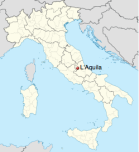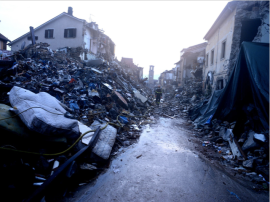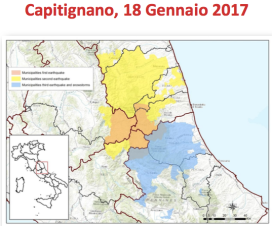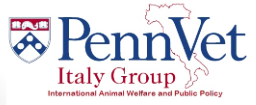Over the past few years you may have heard about several devastating earthquakes that have struck central Italy. Natural disasters are unpredictable events. The emergency management protocols and plans used to help respond to such crises have to be well organized and adaptable.
Given that there have been 3 recent and significant natural disasters in Italy over the past year, we inquired about adding a new topic of emergency management and animal welfare to this years trip. Paolo Dalla Villa, Head of Human-Animal Relationship and Animal Welfare Laboratory at IZSAM, was more than accepting of our request and organized an abridged presentation to fit into our already packed schedule.
IZSAM is a National Reference Center Urban Hygiene and Non-Epidemic  Emergencies (IUVENE) and was officially appointed with this title by the Italian Ministry of Health in 2013. This means they are responsible for supporting the Italian Ministry of Health in all plans and implementation of surveillance, monitoring and control programs on stray dog and cat populations, pests of public health interest and to help with contingency plans surrounding emergency management.
Emergencies (IUVENE) and was officially appointed with this title by the Italian Ministry of Health in 2013. This means they are responsible for supporting the Italian Ministry of Health in all plans and implementation of surveillance, monitoring and control programs on stray dog and cat populations, pests of public health interest and to help with contingency plans surrounding emergency management.
Paolo refreshed us on the definition of disaster, highlighting phrases such as ” serious disruption of the functioning of a community” and “losses and impacts which exceeds the ability of the affected community or society to cope using its own recourses” (United National Office for Disaster Risk reduction, 2015).
The most prevalent disasters in Europe from 2000-2009 include extreme temperature, flood, storm, transport accident, wildfire, and earthquakes. We also learned that the economic damage caused by natural disasters has shown an increasing trend over time. The National Civil Protection System exists to safeguard human life and health, goods, national heritage, human settlements and the environment from all natural or man-made disasters. This department has 14 operational function, and most interesting to note for us is function number 2 – Public Health, Social and Veterinary Assistance. It might be the lack of natural disaster occurrence in our area back home or the fact that the media does not highlight veterinary involvement in emergency management, but I found it so interesting (and refreshing) that the these committees integrated Veterinarians into the mix.

April 6, 2009 L’Aquila experienced a 6.3 magnitude earthquake with over 300 casualties and leaving over 65,000 people homeless. The damaged caused a disruption in the water system which lead to the famous picture of the rat drinking from the water bottle below. Although this occurrence now dates back 8 years, a lot was learned from an emergency response aspect which helped more recent response planning.
In 2016, central Italy experienced 2 earthquakes with in 70 days of each other. Amatrice 6.0 magnitude occurred on August 24 with 300 casualties and 1,300 people assisted. Norcia 6.5 magnitude occurred on October 30 with 1 casualty and 30,000 people assisted.
On August 29, 2016 the Interregional Technical Committee (CTI) was setup to coordinate the technical and operational activities for the protection of animal health, animal welfare, veterinary public health and food safety. This includes all animals, and with the Abruzzo and surrounding central Italy areas having a high number of farms scattered throughout mountain terrain its only logical.

A website and supporting app for smart devices was created in order to provide the general public a way to contact the CTI. It also provided a map which identified all the farms in the area with a color coding system: Green- fit for use, Red- unfit for use, Blue- not impacted
Colors were assigned after a Veterinarian made a visit to check the status of the farm’s infrastructure and animals. IUVENE was able to assess farms and when needed begin the plans for constructing temporary structures for sheltering farm animals. Having Veterinarians on the ground assessing these farms allowed for evaluation of the animals health status in stressful circumstances, welfare status as well as surveillance of any disease.
Capitignano occurred on January 18, 2017. This disaster cause a large amount of issues for the area. A perfect storm of sorts combining blizzard conditions (3 straight days of snow) followed by earthquakes. No sooner would they start to implement an emergency response but they would get set back by an aftershock or another round of snow. In order to gain access to farms in the mountains, they had to enlist army assistance to get through blocked roads. Helicopters guided by GPS coordinates were used to drop hay barrels and food to farms to assure they had some supplies.

Although a bit of a heavy topic, it was fascinating to hear the importance of our role as future veterinarians in such natural disaster emergency situations. IZSAM and the IUVENE is being consulted on an international level for their knowledge on emergency management to help other countries plan for natural disasters that may be encountered.
This lecture has sparked my interest to know more about how the US is structured and how State and Public Health Veterinarians are incorporated into the management plan. A big thank you to IUVENE and Paolo for sharing this inspiring information with our group!
-Christina
all images property of IUVENE and Paolo Dalla Villa








